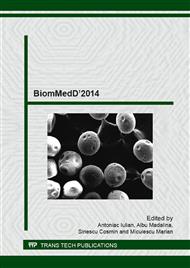[1]
H. Bechhold, Kolloidstudien mit der Filtrationsmethode, Z. Physik Chem. 60 (1907) 257.
DOI: 10.1515/zpch-1907-6013
Google Scholar
[2]
S.I. Voicu, C.M. Ninciuleanu, O. Muhulet, M. Miculescu, Cellulose acetate membranes with controlled porosity and their use for the separation of aminoacids and proteins, Journal of Optoelectronics and Advanced Materials 16 (2014) 903-908.
Google Scholar
[3]
D.F. Stamatialis, B.J. Papenburg, M. Girones, S. Saiful, S.M.N. Bettahalli, S. Schmitmeier, M. Wessling, Medical applications of membranes: Drug delivery, artificial organs and tissue engineering, Journal of Membrane Science 308 (2008) 1-34.
DOI: 10.1016/j.memsci.2007.09.059
Google Scholar
[4]
C. Baicea, A.C. Nechifor, D.I. Vaireanu, O. Gales, R. Trusca, S.I. Voicu, Sulfonated poly (ether ether ketone) – activated polypyrrole composite membranes for fuel cells, Optoelectronics and Advanced Materials – Rapid Communications 5 (2011).
DOI: 10.2478/s11532-012-0175-2
Google Scholar
[5]
A.C. Nechifor, V. Panait, L. Naftanaila, D. Batalu, S.I. Voicu, Symmetrically polysulfone membranes obtained by solvent evaporation using carbon nanotubes as additives. Synthesis, characterization and applications Digest Journal of Nanomaterials and Biostructures 8 (2013).
Google Scholar
[6]
S.I. Voicu, M.A. Pandele, E. Vasile, R. Rughinis, L. Crica, L. Pilan, M. Ionita, The impact of sonication time through polysulfone-graphene oxide composite films properties, Digest Journal of Nanomaterials and Biostructures 8 (2013) 1389-1394.
Google Scholar
[7]
S.I. Voicu, A. Dobrica, S. Sava, A. Ivan, L. Naftanaila, Cationic surfactants-controlled geometry and dimensions of polymeric membrane pores, Journal of Optoelectronics and Advanced Materials 14 (2012) 923-928.
Google Scholar
[8]
F. Miculescu, G.E. Stan, L.T. Ciocan, M. Miculescu, A. Berbecaru, I. Antoniac, Cortical bone as resource for producing biomimetic materials for clinical use, Digest Journal of Biomaterials and Biostructures, 7 (2012) 1667-1677.
Google Scholar
[9]
F. Miculescu, M. Miculescu, L.T. Ciocan, A. Ernuteanu, I. Antoniac, I. Pencea, E. Matei, Comparative studies regarding heavy elements concentration in human cortical bone, Digest Journal of Biomaterials and Biostructures, 6 (2011) 1117-1127.
DOI: 10.4028/www.scientific.net/ssp.188.37
Google Scholar
[10]
F. Miculescu, E. Rusen, A. Mocanu, A. Diacon, R. Birjega, Hierarchical nanostructures of ZnO obtained in the presence of water soluble polymers, Powder Technology 239 (2013) 56-58.
DOI: 10.1016/j.powtec.2013.01.051
Google Scholar


